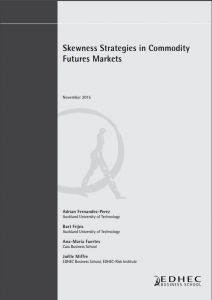

Skewness Strategies in Commodity Futures Markets
Investors are known to display a preference for equities with positive skews (or lottery-like payoffs) and an aversion to equities with negative skews (or those for which the probability of large losses is higher than that of similar large gains). As a result, equities with positive skews tend to be overpriced and thus offer low expected returns, while equities with negative skews tend to be underpriced and thus offer high expected returns. While the pattern is well documented in the equity market literature (see, for example, Amaya et al., 2015, for some recent evidence), the question as to whether skewness matters to the pricing of commodity futures has not yet been addressed. This article is aimed at filling that gap in the literature by designing and analysing the performance of novel skewness strategies in commodity futures markets.
Author(s):
Summary:
Investors are known to display a preference for equities with positive skews (or lottery-like payoffs) and an aversion to equities with negative skews (or those for which the probability of large losses is higher than that of similar large gains). As a result, equities with positive skews tend to be overpriced and thus offer low expected returns, while equities with negative skews tend to be underpriced and thus offer high expected returns. While the pattern is well documented in the equity market literature (see, for example, Amaya et al., 2015, for some recent evidence), the question as to whether skewness matters to the pricing of commodity futures has not yet been addressed. This article is aimed at filling that gap in the literature by designing and analysing the performance of novel skewness strategies in commodity futures markets.
Register to download PDF
Register/Log in| Type : | Working paper |
|---|---|
| Date : | 16/11/2015 |
| Keywords : |
Commodities |

